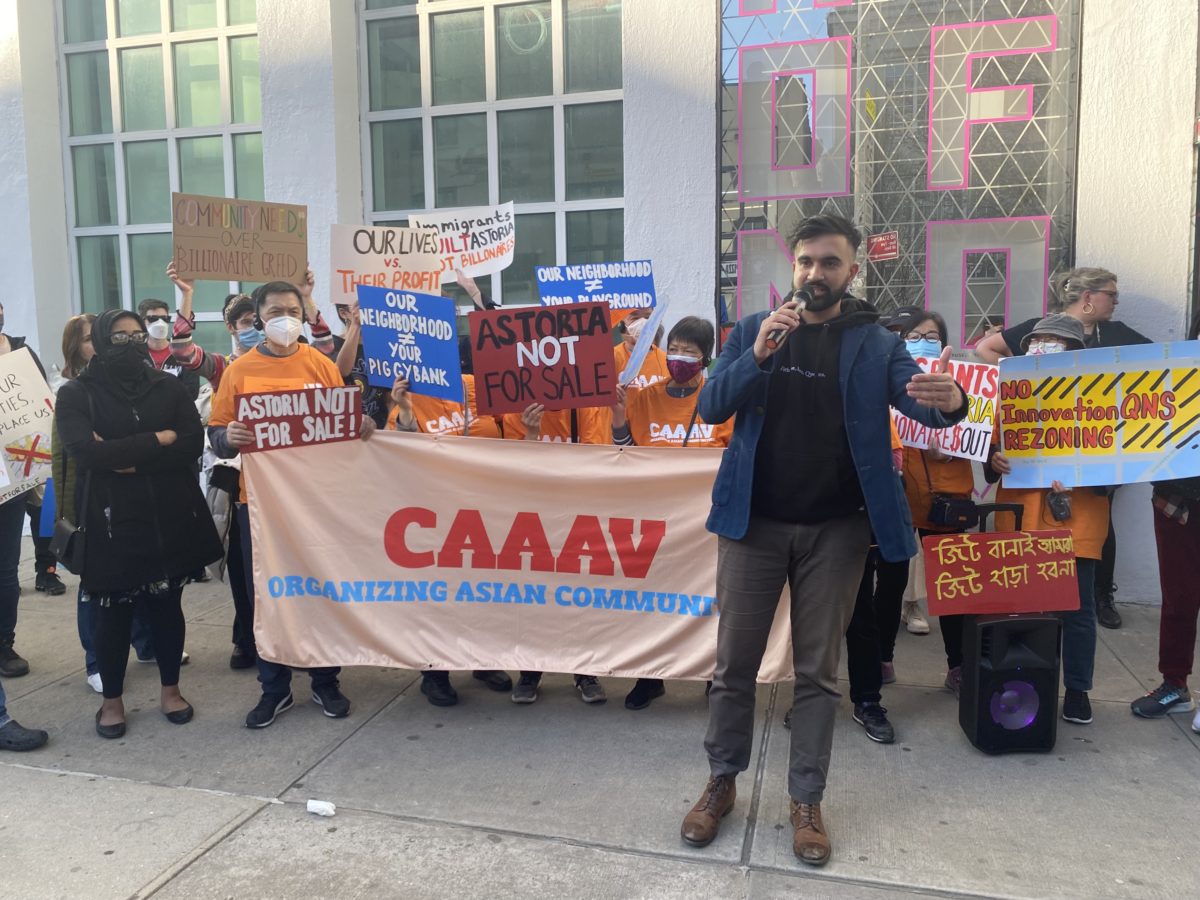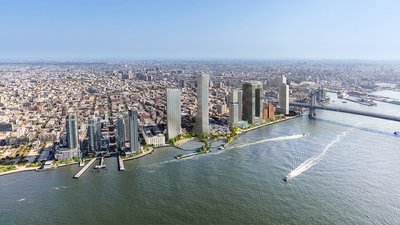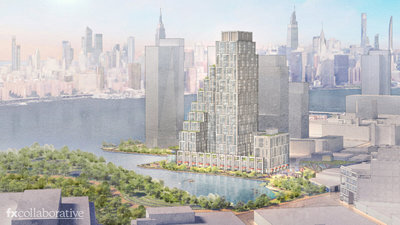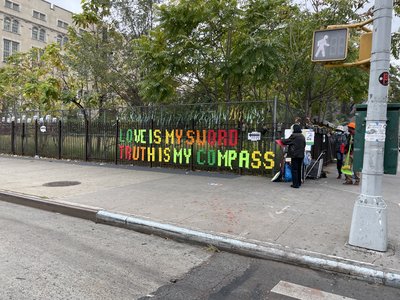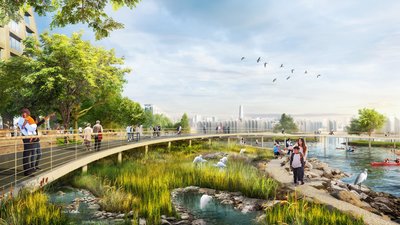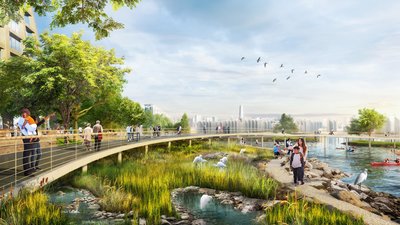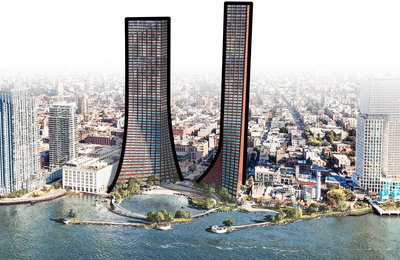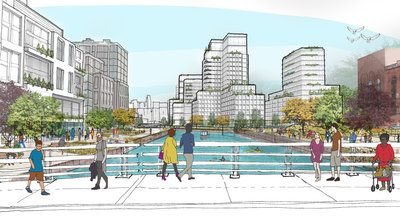Innovation QNS met with community backlash
The development team of Innovation QNS — a project that seeks to rezone five city blocks to build a mixed use residential and commercial district in Astoria — held a town hall meeting at the Museum of the Moving Image last week to discuss community outreach efforts.
Representatives from Kaufman Astoria Studios, BedRock Real Estate Partners, Urban Upbound, and Silverstein Properties gave a presentation and took questions from the hundreds of guests who attended the meeting.
The presentation was met with mixed reactions from union construction workers seeking employment and protestors who were holding signs and chanting “Our neighborhood, not your playground.”
The town hall meeting was announced shortly after Councilwoman Julie Won demanded more transparency and community outreach in a letter to the Innovation QNS team.
“This project has been in the works since 2020 and claims to have done extensive outreach in the community. Community Board 1, local residents, and housing organizations have all expressed concern about a lack of adequate community outreach especially in Spanish and Bangla,” Won wrote in the letter.
“Thus far, the amount of community engagement is insufficient for a project of this scale that will deeply impact not only those in the immediate vicinity, but also will have lasting impacts on the neighborhood as a whole.”
Despite numerous claims from elected officials and concerned residents of a lack of community engagement, the developers maintain the notion that they have and will continue to perform adequate outreach.
“We’ve tried to put this town hall together, we’ve done street canvassing at subway stations throughout the Community Board district and we went door-to-door canvassing in the neighborhood proximate to the sites,” Tracy Capune, vice president at Kaufman Astoria Studios, said.
“We’ve presented a variety of Zoom presentations to over 80 community-based organizations, we’ve held focus groups, we’ve done an online survey that got about 1,200 responses and we’re spreading the word in multiple languages across multiple channels,” she continued. “We are happy to continue to do this outreach, and we look forward to speaking with our local Council Member on how we can address the concerns to the outreach.”
A rally outside the town hall, organized by CAAAV: Organizing Asian Communities, Astoria Not For Sale, Woodside on the Move , Astoria Tenants Union, Justice For All Coalition and Western Queens Community Land Trust , pointed out the flaws in Innovation QNS’ outreach approaches, as well as other reasons why they believe the project would be a disservice to the community.
Evie Hantzopoulos, an Astoria resident, member of Community Board 1 and executive director of the Queens Botanical Garden, referred to their community engagement efforts as “a joke,” citing the fact that the town hall meeting was held during the Orthodox Holy Week, Ramadan, and spring break — a time while many people are unavailable.
“I went to one of those places in the development, talked to the people working there, and they had no idea that their building, where their restaurant is, is part of this proposal and is going to be razed,” Hantzopoulos said.
She added that these types of rezonings are a “ripple effect,” and will further displace local tenants and small businesses in the surrounding area.
“Sometimes the qualifying rent is well above what the median income is for the people who live in that community. The people who desperately need this housing will not be able to qualify, let alone apply — and it’s a lottery system,” she said. “If you are going to construct this huge development, which is going to be over 75 percent unaffordable to the community, you have to know what you’re going to be charging for those. You’re not being transparent about that.”
 Tracey Appelbaum, co-founder of BedRock Real Estate Partners, responded by saying that the development team understands the housing crisis present in New York City, and that they would provide 700 permanently affordable housing units. Twenty-five percent of the 2,800+ units would be affordable for those making $50,000 annually, and 60 percent of units would be within the price range of area median income.
Tracey Appelbaum, co-founder of BedRock Real Estate Partners, responded by saying that the development team understands the housing crisis present in New York City, and that they would provide 700 permanently affordable housing units. Twenty-five percent of the 2,800+ units would be affordable for those making $50,000 annually, and 60 percent of units would be within the price range of area median income.
The proposed $2 billion development would build 12 towers between Northern Boulevard and 37th Street, ranging from nine to 27 stories tall.
The towers would house over 2,800 apartments, offering more than 100 dedicated homes for seniors, as well as 5,400 on-site jobs and two acres of permanently publicly accessible open space.
NYS Assemblyman Zohran Mamdani, who rallied alongside the community groups, said that Astoria is in the midst of a massive displacement crisis.
He argued that developments like Innovation QNS actively contribute to the problem.
“If you have more than 2,000 market rate apartments coming here without a guarantee or commitment as to what those prices will be, we will simply see more and more landlords looking at those projected units as the new going rate for living in Astoria,” Mamdani said.
“I will never stand in opposition to affordable housing. What I will stand in opposition to are projects that masquerade as such,” he said. “That is where the genesis of my critique and opposition to this project comes from.”
Doreen Mohammed, a resident and CB1 member said: “As a working class, first generation Bangladeshi-American who grew up in Queens, I have seen firsthand how luxury developments like Innovation QNS are harmful for working class New Yorkers. They spike up the rents and cost of living in the immediate and surrounding areas. They yield violent displacement of people.”
“We need deeply, truly affordable, and accessible housing for all working class and poor New Yorkers,” Mohammed said.. “Innovation QNS will displace our vulnerable immigrant, working class, communities of color. This is why we must oppose this rezoning and fight to end this project.”




